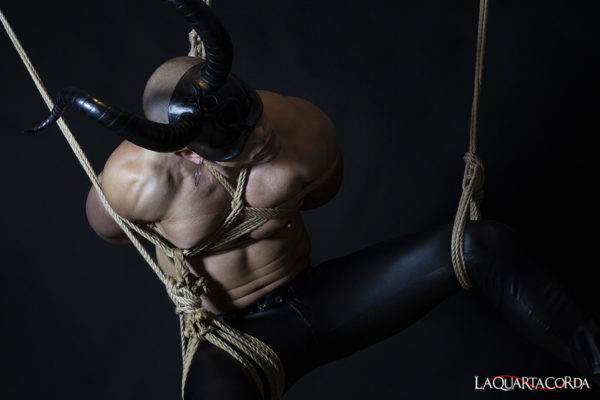
Tying someone with their hands behind their back is perhaps the most iconic form of Japanese bondage.
But what is the name of this figure? “Gote” or “takatekote”? Or “munenawa”?
It is not easy to answer this question.
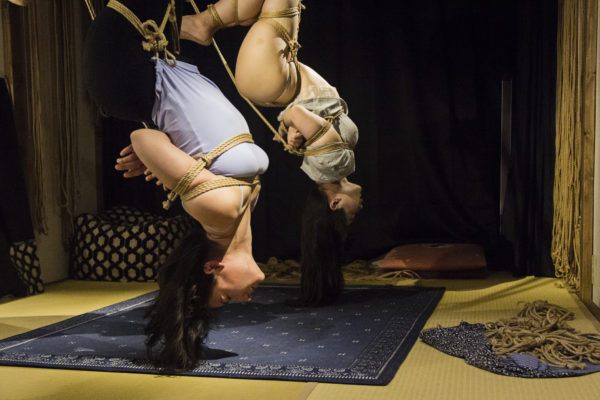
Meanwhile, we can say that “gote” and “takatekote” are the abbreviation of “gote shibari” and “takatekote shibari”, where “shibari” means “binding”; it must be said that these terms – at least since the post-war period – are generally used in their shortened form.
“Munenawa”, on the other hand, means rope (“nawa”) on the chest (“mune”) and thus indicates any tying practice that constricts the torso but does not necessarily include the hands.
To this day most Japanese masters mean by “gote” any upper body harnes with the hands behind the back and by “takatekote” more specifically a structure in which the hands behind the back are crossed at the top, with the arms bent at an acute angle.
So use these words with this meaning freely and you’re sure to be right!
But be aware that they are not universally accepted meanings and have not always been so.
“Gote shibari” (後手), as we said, means all bindings (“shibari”) in which the hands (“te”) are behind (“go”) the back. It can also be called “ushirode shibari”, because the kanji “go” can also be read “ushiro”.
If instead the hands are tied in front of the chest then the suffix “mae” is used, hence “maete shibari”.
So far so simple.
Beware however that the term “te” in Japanese does not indicate a specific part of the body, but the arm in general, from the shoulder to the fingertips, therefore “te” can refer both to the “arm” and to the “hand”.
Having said that, we now come to the word “takatekote” (高手小手) or “takatekote shibari”.
The expression “takatekote” has always been present in Japanese and is generally found associated with the verb “shibaru” (“to tie”) and means “with arms and hands (tied)”.
It is also found in the Japanese-English dictionary of 1867 by J. C. Hepburn (the American missionary who invented the Japanese transcription system of the same name).
In it, in fact, we can read “Takadekode, adv. Used in the phrase ‘- ni shibaru’, to tie the hands behind the back”.
This expression is also found in contemporary dictionaries, such as the famous Sanseido, which for “takatekote” reads “両手をうしろに回して、二のうで〔=高手〕から手首まで厳重に しばること”, that is, “the act of tightly tying the arms behind the back from the upper arm (=takate) to the wrist”.
Seiu Ito also uses this expression for example in “Seme no kenkyu” (“責めの研究”, “Research on torture”) from 1928, where we can find “荒縄で高手小手に縛られて” meaning “with the arms and the hands tied with a straw rope”.
In short, “takatekote” is almost a synonym for “gote,” although only “gote” explicitly indicates that the arms are behind the back.
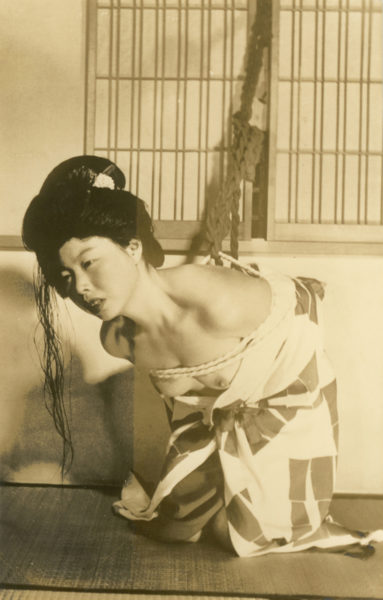
Nowhere in the definitions seen so far, however, do we find a reference to the wrists being turned upward.
So how did this new meaning of the term “takatekote” come about?
“Takatekote” is an expression made up of four kanji that individually mean
– taka (高), high
– te (手), arm/hand
– ko (小), small
– te (手), arm/hand
So, translating one kanji at a time, we would get the expression “high hand small hand”, or “high arm small arm”, which means nothing.
We can then try to split “takate” and “kote”, two words that actually exist even individually in the Japanese language.
“Takate” (高手) can mean either “upper arm” or “hands up”, while “kote” means “lower arm”.
This already makes more sense, although let’s remember that in Japanese “takatekote” is an expression to be taken all together, without dividing it, and that it means, as we have already said, “arms and hands”.
However, some nawashi have referred to different “etymologies” of the word “takatekote”.
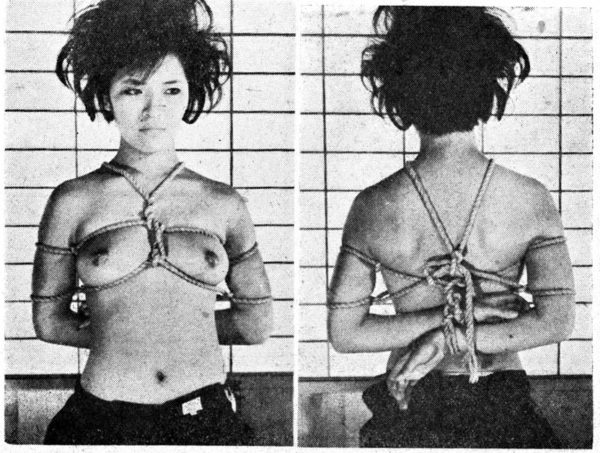
In the September 1961 issue of the Kitan Club magazine Tsukamoto Tetsuzo illustrates a tutorial on how to make “the simplest version of takatekote” explaining that takatekote is so called because “高手小手という言葉の,高手がニの腕に当り, 両手首が小に当るのですから,てれで,高手と小手の両方に,縄を掛けたてとになります”, meaning “in the word takatekote, takate refers to the upper arm and kote to the wrists, so [it means that] the rope should tie both arms and wrists”.
So Tsukamoto meant “takate” as the upper part of the arm (i.e., “ude,” 腕).
But there were also those who explained “takate” as “hands up”.
For example, Minomura Koo in the first volume of “美しき縛しめ” (“Utsukushiki imashime”, “Beautifully bound”) from 1953, in the caption of the photo titled “Takatekote” writes: “Starting with my hands behind my back, I passed the rope over my neck and raised my wrists above the horizontal line. Her head then tilted back and her face looked up. This showed when the hands were pulled upward. I also tightly turned the advanced rope at the top of her arms twice. This is literally a ‘takatekote'”.
This meaning of the term “takatekote” is the one most commonly used today and probably this change in meaning only emerged in the bondage environment.
It can be assumed that the choice to differentiate ties with horizontal or downward wrists from those with upward wrists was also due to the fact that this second position was considered aesthetically more interesting because it “gives a feeling of slavery” (“緊縛感を現している言ろこともいえる”), as also stated by Takashi Tsujimura in “後手と高手小手による緊縛美の考察” (“Considerations on the beauty of kinbaku in gote and takatekote”), an article in the April 1953 issue of Kitan Club.
This would also be the aesthetic taste of other artists, such as Nureki Chimuo. For example in one of his “緊縛ナイショ話” (“Kinbaku confidential blog”), Nureki sensei writes “私に限っていえば、私が最もエロチシズムを感じ、興奮するのは、女性を後ろ手にして、その手首が背後の高い位置で交差され、固定されている眺めである。つまリ、高手小手である。” meaning “as far as I’m concerned, what I find most erotic and exciting is to see a woman’s back with her wrists crossed and bent up. In other words, it’s a takatekote”.
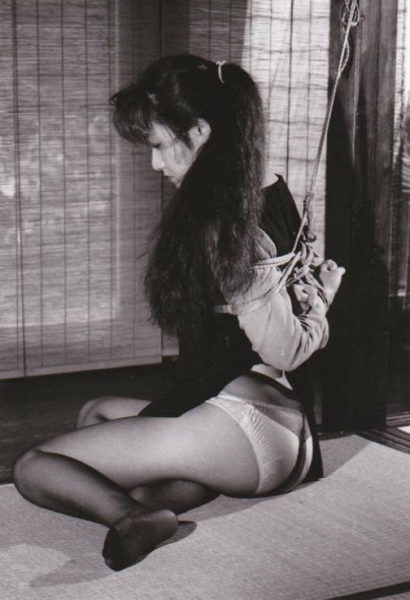
Probably in the 1950s and 1960s, a “pioneering” era for the development of modern Japanese bondage, there was a certain “experimentalism” in both the techniques and the definition of them.
“Takatekote” could denote different forms from each other, and the same bondage could be called “gote,” “ushirode shibari,” “takatekote,” or even “gote takatekote”, as in a photo in the February 1964 issue of Kitan Club.
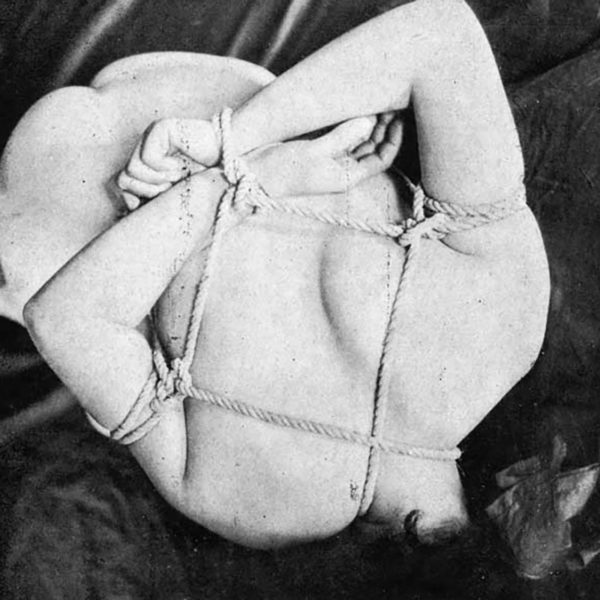
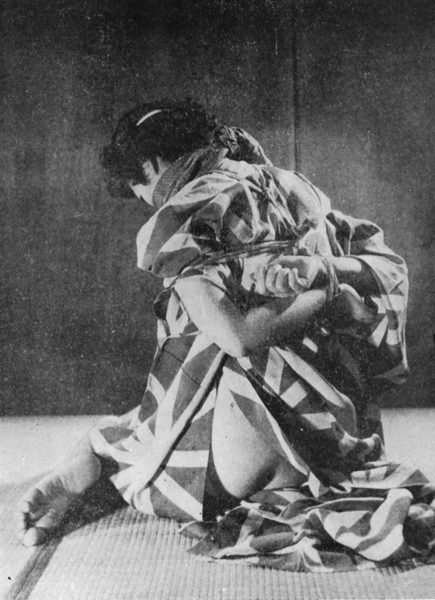
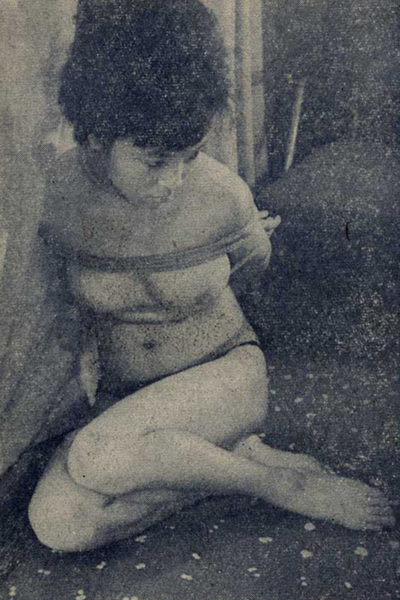
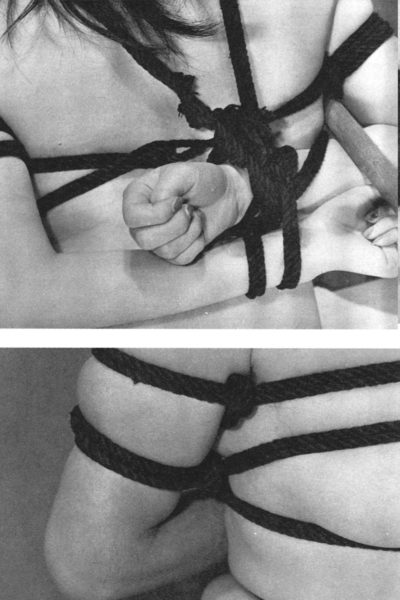
In fact, the naming and explanation of the forms used in Japanese bondage is extremely unbounded and, unlike in the West, there is no interest in “naming” or “standardizing” tying practices.
Even to this day, there are nawashi who use only the term “gote” to refer to any bindings with arms behind, others who distinguish between “gote” and “takatekote”, and still others who use both terms interchangeably.
So there is no solution other than to use a generic “gote” on each occasion – perhaps specifying the position of the hands – or to orient ourselves based on our own considerations or the choice of the teacher with whom we studied.
Fortunately, as Shakespeare said, “that which we call a rose by any other name would smell as”!
REFERENCES
Kinbakunomicon, episodes 6 and 20: https://www.kinbakunomicon.com
Hepburn dictionary, 1867 edition: https://deriv.nls.uk/dcn23/7988/79881705.23.pdf
Gote / takatekote on Nawapedia: http://nawapedia.com/index.php?title=Gote_takatekote
Kitan Klub online: https://nawa-art.com/backnumber/backnumber.htm
“Beautifully bound” on Kinbaku books: https://kokoro-kinbaku.com/2015/01/21/beautifully-bound-1953-a-presentation/
Thanks to I.M. for the precious help with Japanese translations.